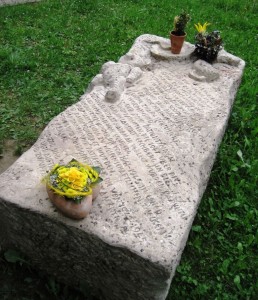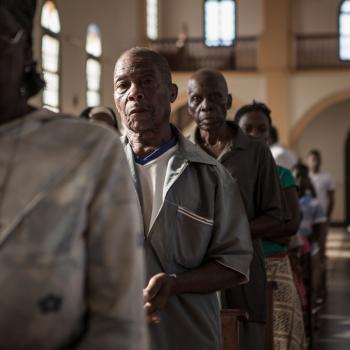 The arrival of so many small children at the tiny train station at Hattenheim could not have gone unnoticed . . .
The arrival of so many small children at the tiny train station at Hattenheim could not have gone unnoticed . . .
These attempts to shed light on the atrocities committed at the Eichberg may have done little to change the regional population’s lack of interest in this topic, however.
—Lutz Kaelber
“You ever eat grass-fed beef?” This from a biker in Starbucks, eavesdropping on my conversation with a friend.
“Yeah,” I said. “It’s good.”
He curled his lip. “Tastes like grass.”
“You have to cook it right,” I told him.
He grunted disapproval. A confederate flag was stitched to his sleeve and he wore a Penn State cap. I suppose that willingness to display the former is evidence of a certain inurement to public opinion that enables one to impart lifestyle instruction to strangers while wearing the latter.
In the week after former Penn State assistant football coach Jerry Sandusky was convicted of forty-five counts of child sexual abuse, analysts reported sales of Penn State merchandise were forty percent lower than normal. That was still sixty percent too high for me.
I’m sure sales will creep higher as people forget about what Jerry Sandusky did there. The forgetting can’t happen soon enough, according to sports writer Adam Jacobi. “The school just needs a continuation of the usual,” he writes.
A continuation of the usual. I don’t know how much more this heart-sickened world can bear to continue the usual.
Instead of continuing the usual, I propose that Pennsylvania authorities raze every building where Sandusky raped a child. Afterward, they should raze every building where Penn State officials—including the university’s president, head of university police, athletic director, and revered football coach—agreed to ignore his predation.
Finally, after the demolition crews have taken a break, they should raze Beaver Stadium, because we all know that if Jerry Sandusky had been assistant chemistry professor rather than assistant football coach, he would have gone straight to jail years earlier.
It’s not uncommon to destroy buildings where great evil has occurred. After pediatrician Earl Bradley was convicted on 103 counts of raping or molesting children in Lewes, Delaware, his town demolished the site where he preyed on them. Likewise, a community group in Milwaukee bought the apartment building where Jeffrey Dahmer desecrated so many bodies, and tore it down.
The purgative instinct doesn’t always carry the day. People in the low-income Brownsville, Texas neighborhood where John Allen Rubio and Angela Camacho beheaded their three small children don’t have the clout to combat preservationists enamored with the murder site’s architecture, but they’ve made clear they want it destroyed.
Perhaps we tear down structures that have hidden evil because, as French historian Pierre Nora says, “Memory attaches itself to sites, whereas history attaches itself to events.”
We tear down sites where evil was done as one might sever a rotted limb and cauterize the stump. Sometimes we mark the place, a signpost for future generations, as the Cambodians did with the Tuol Sleng school, site of Khmer Rouge tortures, as Germans did at Auschwitz, as Rwandans did at Murambi where gutless French soldiers let 45,000 Tutsis be hacked to death and then built a volleyball court over their graves.
The instinct of those who feel complicit in evil is either to confess it, or to hide it.
Consider the Eichberg and Kalmenhof hospitals, where German doctors and nurses murdered hundreds of “defective” children and babies during the second world war, in what they called “special children’s wards.” Sociologist Lutz Kaelber found that townspeople quickly wrote the crimes out of their history, such that in 1978 a director at Kalmenhof could earnestly declare that nobody was killed by Nazis in his facility.
Cultural critic Norman Klein writes: “Forgetting is a twin: its tandem effect is best called ‘simultaneous distraction,’ the instant when one memory defoliates another.”
We forget best, in other words, when we have something to displace the memories we associate with a site. Like that French volleyball court.
Like football, pep rallies, homecomings, and graduations. Like a thousand distractions that will help Penn State boosters forget that an utterly corrupt administration—from the president to the janitors—enabled a serial child rapist because of an insatiable hunger for football victories.
In this light, the university’s removal of Joe Paterno’s statue doesn’t sound punitive. It sounds like people bent on forgetting.
I wonder if Penn State will yield what Kaelber calls “memory agents.” These are people like two pastors at Eichberg, who started giving visitors and patients tours in 2005, because the small memorial to the 476 children murdered there was obscured.
Similarly, for fifteen years after the war, an unknown Kalmenhof nurse led groups of schoolchildren to the grounds where bodies of at least 369 executed children had been chucked in the dirt.
“Remembering was arduous,” Klein writes of the task facing classical scholars. And it still is. We must be deliberate about embedding memory in our surroundings.
Sometimes, when a great, shameful evil has been allowed to take root, the best reminder is a hole, a vacant place. That emptiness, like a cauterized wound, can serve as a reminder to all who see it that something rotten once grew there. Something rotten we allowed to grow so deep that we had to cut it away.
Note: Lutz Kaelber is quoted from the article “Child Murder in Nazi Germany: The Memory of Nazi Medical Crimes and Commemoration of ‘Children’s Euthanasia’ Victims at Two Facilities (Eichberg, Kalmenhof).”














